Choosing the right baseball glove for an 11-year-old is a decision that goes beyond simple equipment selection. At this stage of development, young players are transitioning from beginner-level skills into a more advanced understanding of the game. The glove they wear has a direct influence on how confidently they catch, throw, and field the ball. The main question most parents ask is: What Size Baseball Glove for 11 Year Old? The answer depends on a combination of factors such as hand size, playing position, material preference, and even whether the glove is designed for boys or girls.
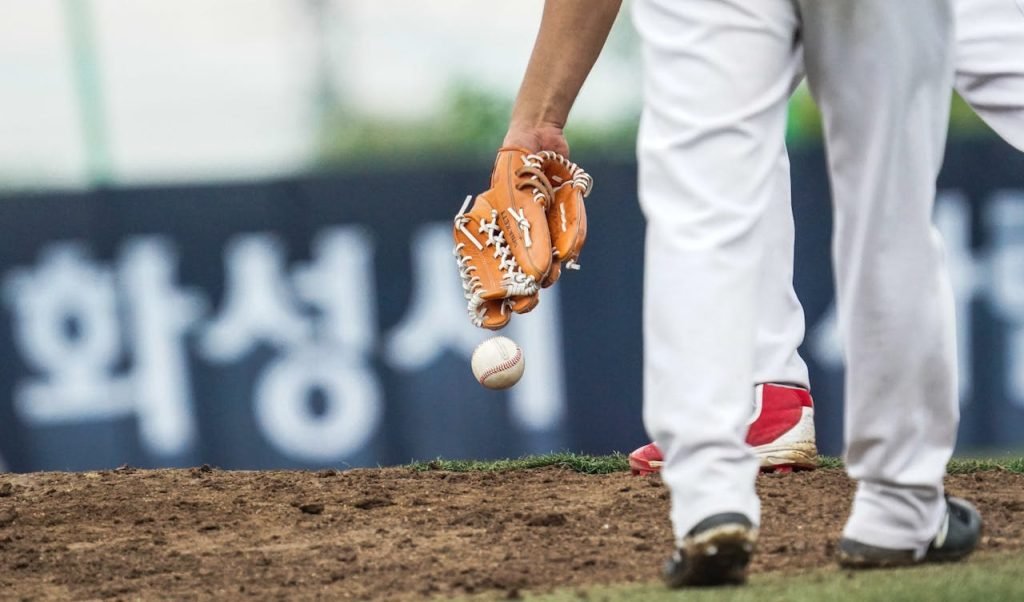
Baseball is often described as a game of inches, and the same applies to glove sizing. A glove that is even half an inch too big or too small can change how easily a child fields ground balls, catches fly balls, or makes quick throws across the diamond. This article provides a complete expert guide on selecting the perfect baseball glove for 11-year-olds. By the end, you will not only know the right sizes but also how to measure, what brands to trust, and what mistakes to avoid so your child can step on the field with confidence.
Why Glove Size Matters at Age 11
At 11 years old, children are entering the age where coordination, hand strength, and reaction time are improving rapidly. A properly sized glove enhances these natural developments by ensuring that the child can move the glove quickly, close it fully, and control the ball effectively. A glove that is too large will feel heavy, slow to maneuver, and may cause balls to slip out during catches. Conversely, a glove that is too small will feel tight, limit flexibility, and even cause hand discomfort or blisters.
The right glove size boosts both performance and confidence. When an 11-year-old player can rely on their glove to respond naturally to their hand movements, they spend less time adjusting and more time focusing on the game. This helps with building trust in their own abilities. A properly fitted glove also minimizes the risk of injuries by reducing strain on developing hand muscles and ligaments.
Key Factors When Choosing a Baseball Glove
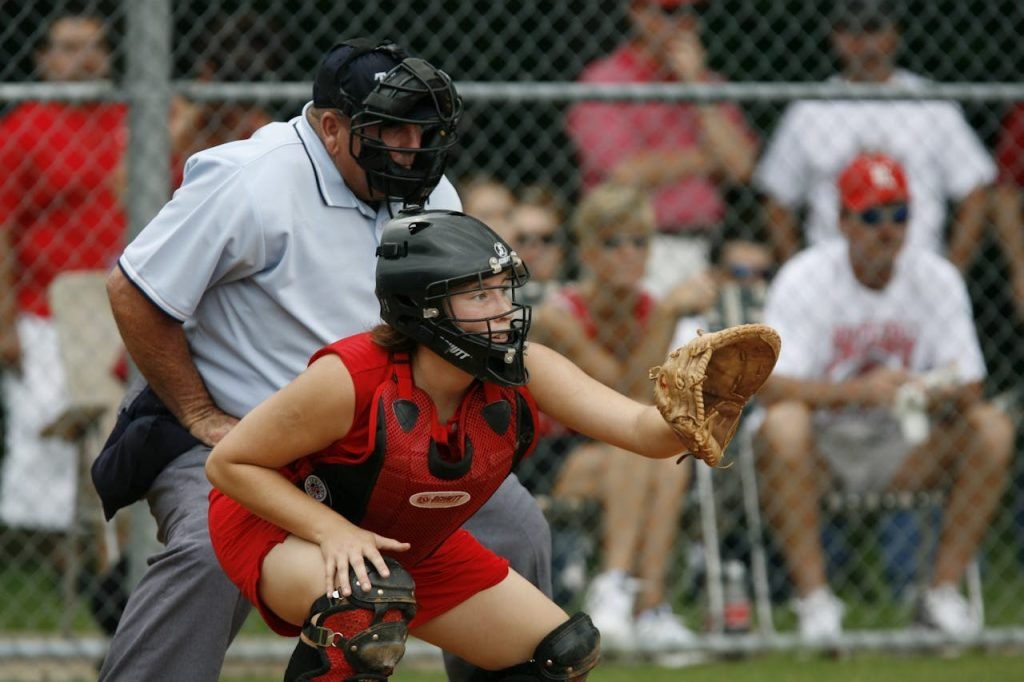
Player’s Position
The most important factor in glove size is the position your child plays. Each position in baseball requires slightly different glove dimensions to maximize performance.
- Infielders (10.5–11.5 inches): Infield gloves are designed to be smaller with shallow pockets, allowing for quick transfers from glove to throwing hand. An 11-year-old playing shortstop, second base, or third base will benefit from a glove in the 10.5–11.5 inch range because it provides control and speed, which are essential for fielding ground balls and making fast throws.
- Outfielders (11.5–12.5 inches): Outfield gloves are larger to create deeper pockets, making it easier to catch fly balls and line drives. For 11-year-olds playing left, center, or right field, a glove between 11.5 and 12.5 inches gives them the extra reach needed to snag balls hit into the gaps.
- Pitchers (11.5–12 inches): Pitchers often choose gloves that are versatile in size and provide concealment of the ball before delivery. A glove in the 11.5–12 inch range is ideal for an 11-year-old pitcher because it balances comfort with the ability to hide grip changes from the batter.
- Catchers (specialized mitts): Catcher’s mitts are entirely different from other gloves, featuring more padding and a unique design to handle fast pitches. Youth catcher’s mitts for 11-year-olds usually range from 30–31 inches in circumference rather than standard inch measurements.
Hand Size and Strength
The glove must fit the player’s actual hand, not just their position. Measuring the hand ensures accuracy. Children with smaller hands may struggle to open and close larger gloves, while stronger players can handle heavier, sturdier models.
- Hand measurement 6.5–7.5 inches: Best suited for gloves sized 10.5–11 inches. This range is often for smaller or less physically developed 11-year-olds.
- Hand measurement 7.5–8.5 inches: Works best with 11–11.5 inch gloves, which balance size and mobility for most youth players.
- Hand measurement 8.5–9.5 inches: Suitable for larger 11-year-olds who may already be transitioning toward adult-sized gloves. They can comfortably manage gloves between 11.5 and 12 inches.
Strength also matters. A player with stronger wrists and fingers can break in a stiffer leather glove more easily. A player with less strength should start with a lighter synthetic glove for better maneuverability.
Gender Considerations: Boys vs Girls

Parents often ask about differences in glove sizing for boys and girls at age 11. While the basic sizing principles remain the same, comfort and hand fit can vary.
- What size baseball glove for 11 year old boy: Boys often have slightly larger or stronger hands at this age, which means they may handle gloves closer to the 11.5–12 inch range comfortably, especially if playing in the outfield.
- What size baseball glove for 11 year old girl: Girls may prefer lighter gloves, usually in the 10.5–11.5 inch range, which provide better control without feeling bulky. Many manufacturers also design youth softball/baseball gloves specifically tailored for female hand shapes, offering narrower finger stalls and softer padding.
- Women vs Men baseball gloves: Women’s gloves are generally lighter, with a snugger hand opening. Men’s gloves often emphasize durability and thicker padding. For 11-year-olds, these differences are subtle, but choosing a glove designed for their hand size and comfort level makes a big difference.
Materials and Construction
Leather vs Synthetic Gloves
The material of the glove plays a big role in performance and durability.
- Leather gloves: These are the gold standard. They mold to the hand over time, providing a custom fit that improves control and performance. Leather gloves are more durable and, with proper care, can last multiple seasons. However, they take longer to break in and are more expensive, making them an investment option for committed players.
- Synthetic gloves: Lighter, more affordable, and easier to break in. They are ideal for beginners or casual players who need a glove ready for play right out of the box. Synthetic gloves resist weather conditions better than leather but typically do not last as long.
Durability and Comfort
Durability ensures that the glove will withstand the wear and tear of a baseball season. Leather gloves can often last for years with proper oiling and storage. Comfort is equally important, especially for 11-year-olds who may wear the glove for long practices and games. Synthetic gloves provide immediate comfort but may wear out faster.
How to Measure a Child’s Hand for Glove Size
Step-by-Step Process
Measuring your child’s hand is the foundation for choosing the correct glove size.
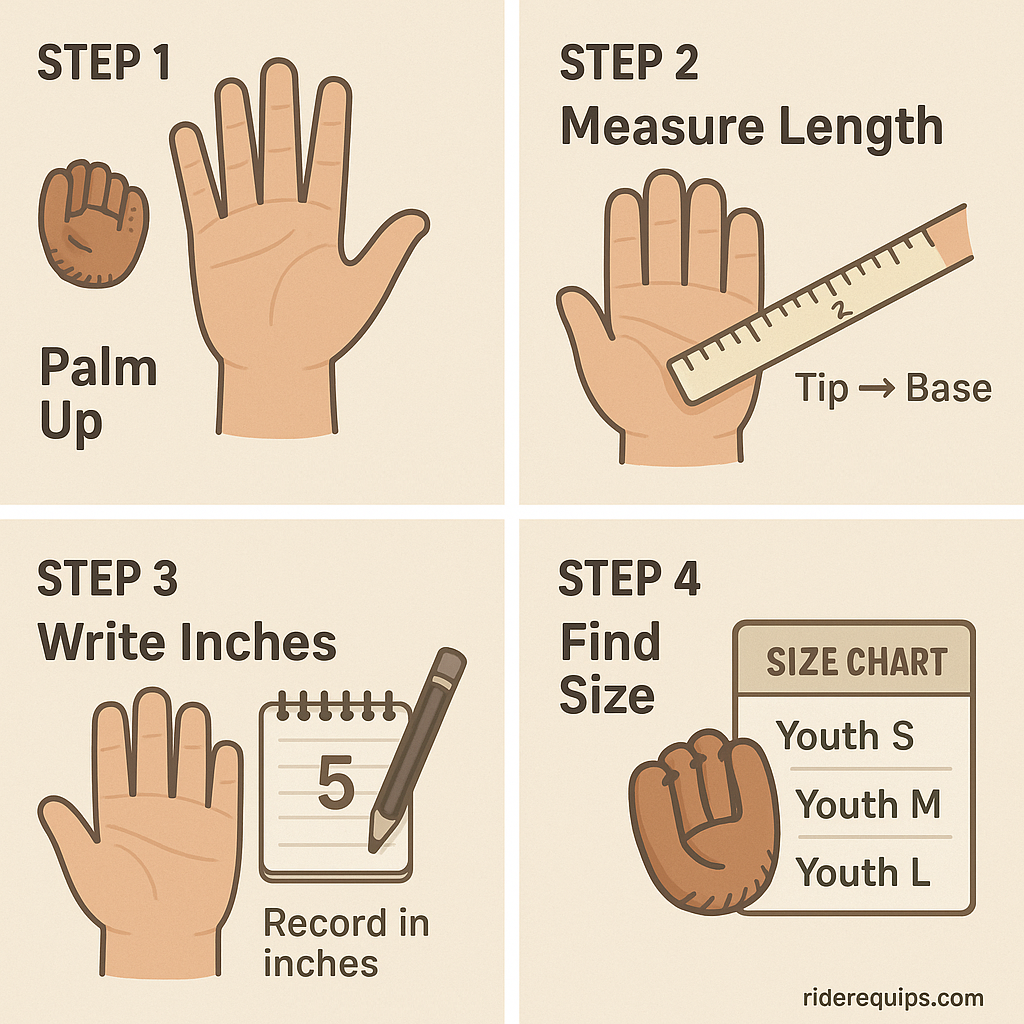
- Have the child extend their hand palm-up.
- Place a flexible tape measure or string from the tip of the middle finger down to the base of the palm.
- Record the measurement in inches.
- Match the hand measurement to the recommended glove size chart.
Youth Baseball Glove Size Chart
| Hand Measurement | Recommended Glove Size |
| 6–6.5 inches | 10.5–11 inches |
| 6.5–7.5 inches | 11–11.5 inches |
| 7.5–8.5 inches | 11.5–12 inches |
Types of Baseball Gloves
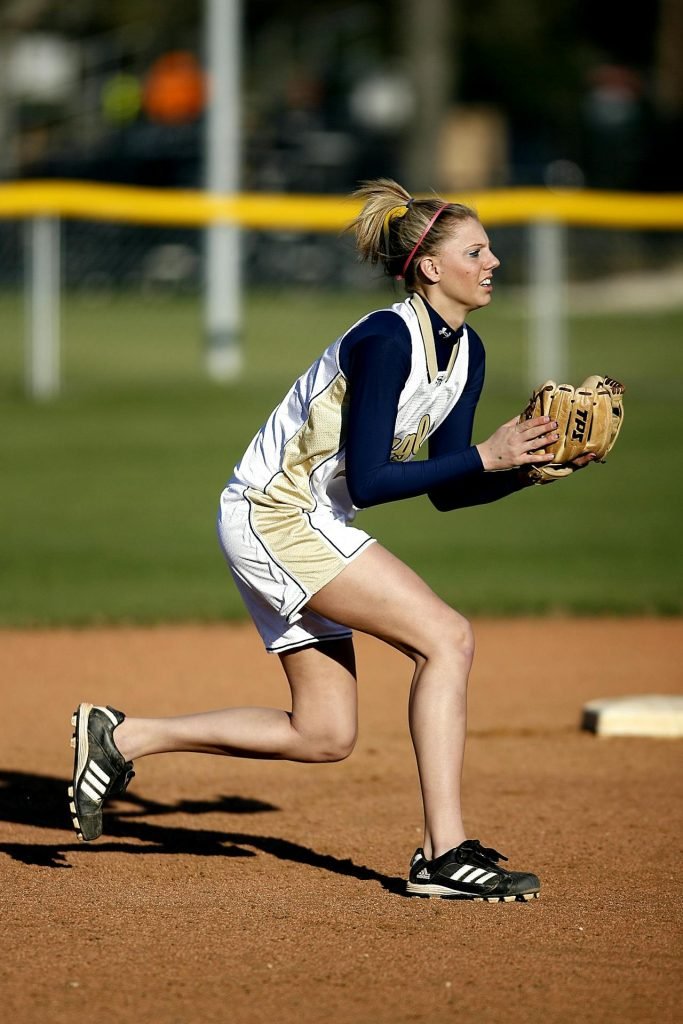
Infield Gloves
Infield gloves are compact with shallow pockets. They are designed to scoop up ground balls quickly and allow fast throws. For 11-year-olds, the recommended size is 10.5–11.5 inches depending on hand size and fielding preference.
Outfield Gloves
Outfield gloves are larger, with deeper pockets to secure fly balls. An 11-year-old outfielder should use gloves ranging between 11.5–12.5 inches. These gloves provide the extra reach needed to snag line drives and balls hit over the head.
Pitcher’s Gloves
Pitcher’s gloves are versatile and designed with closed webs to hide grip changes. For an 11-year-old pitcher, gloves in the 11.5–12 inch range are perfect. This size allows concealment while still being light enough to maneuver comfortably.
Catcher’s Mitts
Catcher’s mitts are highly specialized, with additional padding and a unique design to handle repeated fast pitches. For an 11-year-old catcher, youth mitts around 30–31 inches in circumference are recommended.
Top Baseball Glove Recommendations for 11-Year-Olds

Best Brands
Several brands consistently deliver high-quality baseball gloves for youth players:
- Rawlings: Known for its craftsmanship and high-quality leather, Rawlings gloves often come with excellent padding and durable stitching. Many youth models are specifically tailored for comfort and easy break-in.
- Wilson: Offers a wide range of youth gloves, with the Wilson A2000 being a standout for durability, snug fit, and professional-level quality adapted for younger players.
- Mizuno: Popular among youth players for providing affordable yet reliable gloves. Mizuno Prospect gloves feature PowerClose technology, making it easier for kids to close the glove securely.
- Easton: Produces gloves that are lightweight, easy to break in, and budget-friendly. Easton’s youth series focuses on beginner and intermediate players.
Popular Models
- Rawlings Prodigy Series: Made from soft leather with a secure fit. Easy to break in, making it a great choice for young players transitioning into competitive baseball.
- Wilson A2000: High-quality leather construction ensures durability and long-term use. The glove provides excellent padding, making it comfortable for extended gameplay.
- Mizuno Prospect Series: Designed to make catching easier, these gloves are affordable and feature lightweight construction suitable for 11-year-olds.
- Easton Future Elite: Offers flexibility and comfort at a reasonable price point. Ideal for players just beginning to take baseball more seriously.
Mistakes to Avoid When Buying a Glove
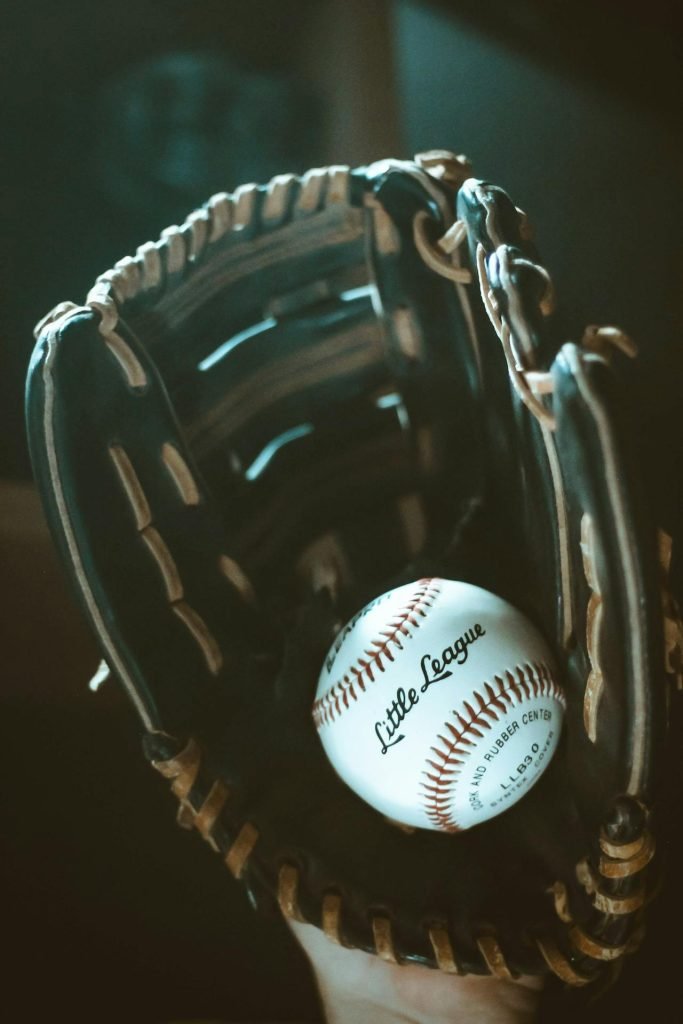
Parents often make mistakes when buying gloves for their children. Here are some common ones:
- Buying a glove too big for growth: A glove that is oversized may seem like a cost-saving choice, but it can slow reaction times, slip off during plays, and hurt development. At age 11, comfort and performance are more important than growing into the glove.
- Ignoring position requirements: An infielder using an oversized outfield glove will find it difficult to transfer the ball quickly. Always choose a glove size suited to the position played.
- Skipping measurement: Guessing glove size without measuring the child’s hand often leads to poor fits. Measuring ensures accuracy and saves money in the long run.
- Overlooking break-in needs: Leather gloves require time to break in. Parents who expect immediate use may prefer synthetic gloves for their children.
Parents’ Buying Guide
Budgeting for Quality
While premium gloves can be expensive, they often last for several seasons if cared for properly. If your child is deeply committed to baseball, investing in a leather glove is worthwhile. If they are just starting or playing recreationally, a synthetic glove may be more practical.
Break-In Process
Leather gloves require conditioning and use before they feel game-ready. The process involves using glove oil, a mallet, or simply playing catch to shape the glove to the child’s hand. Breaking in the glove ensures comfort and flexibility during gameplay.
Growth Considerations
It can be tempting to buy a larger glove with the idea that your child will “grow into it.” However, oversized gloves hinder performance and may frustrate young players. It is better to buy a glove that fits now and replace it after one or two seasons as the child grows.
Frequently Asked Questions
What Size Baseball Glove for 11 Year Old?
Most 11-year-olds perform best with gloves between 11 and 12 inches, depending on position.
What size baseball glove for 11 year old boy?
Boys usually wear 11–12 inch gloves. Outfielders benefit from gloves closer to 12 inches.
What size baseball glove for 11 year old girl?
Girls often use gloves between 10.5 and 11.5 inches, designed to fit smaller hands comfortably.
Is a 12-inch glove too big for an 11-year-old?
Not necessarily. For outfield play, a 12-inch glove can be appropriate. For infielders, it is usually too large.
How to size a baseball glove for a kid?
Measure the hand, match it with a size chart, and ensure the glove feels snug but comfortable when worn.
Conclusion
Selecting the right baseball glove for an 11-year-old is one of the most important equipment decisions parents and coaches can make. The correct glove size enhances performance, builds confidence, and prevents injuries. The answer to What Size Baseball Glove for 11 Year Old depends on several factors: playing position, hand size, strength, gender considerations, and material preference. Most 11-year-olds thrive with gloves in the 11–12 inch range, though infielders may need smaller gloves and outfielders slightly larger ones.
Ultimately, the best glove is one that feels like an extension of the child’s hand. Parents should prioritize proper fit and comfort over cost savings or “growing into” a glove. With the right choice, a glove can support a young athlete’s development, help them enjoy the game more, and prepare them for the next stages of their baseball journey.
Recent Posts
When you slip on a pair of cycling gloves and grab your handlebars, you’re not just putting on protection — you’re gripping layers of carefully engineered padding. These layers, made mostly of...
When you see someone wearing gloves while working on bike shifters—whether it’s during a roadside repair or in a professional workshop—you might wonder: why do people wear gloves while working...
